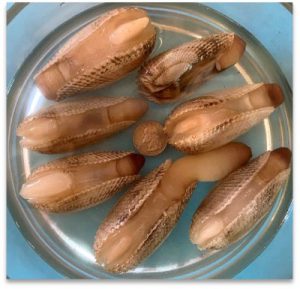The potential for commercial aquaculture development of the angelwing clam Cyrtopleura costata, a burrowing bivalve found along the US Atlantic and Gulf of Mexico coasts, was reexamined. Studies conducted in the 1980s demonstrated angelwings could be spawned using hatchery methods similar to those for commercial bivalve species. Preliminary results also indicated angelwings grow rapidly and could reach a potential harvest size in six months. However, the lack of economical production methods and harvesting techniques stymied further consideration of angelwings as an aquaculture candidate species. Despite its excellent flavor and attractive shell, another drawback was its short shelf life as most bivalves until recently were marketed as live shellstock. In the past two decades, aquaculture of the geoduck, North America’s largest phollad clam, has advanced due to its high market value. By adapting methods developed for geoduck aquaculture, it was hypothesized that reliable production of the angelwing clam could be achieved.
 In this study, adult angelwing clams were sourced from local populations in Cedar Key, FL and successfully spawned and reared in a commercial hatchery with similar results as previous studies. A notable exception was that pediveligers set equally well in sand substrate and without substrate. Post-set (2-3 mm) were nursed in sand-filled tanks reaching 11-12 mm in 14-22 days, at which time juveniles were of the size to be planted in the field. Several field and land-based culture methods were evaluated: PVC tubes under bottom nets, submerged bottom cages, modified bottom bags, and raceway tanks. After 23-24 weeks (six months from spawning), angelwings reared in the field (bottom plant) averaged 62 mm in shell length and 24 grams in total weight, whereas angelwings in raceways averaged 46 mm and 5 grams. Although survival in the bottom plant was low (<20%), this is a potentially viable growout method with improved management practices. Two post-harvest processes were tested: modified atmosphere packaging for live product, and frozen and vacuum skinned packaging. Preliminary evaluation of these processes for shelf life, breakage, and appearance was conducted by a commercial processor.
In this study, adult angelwing clams were sourced from local populations in Cedar Key, FL and successfully spawned and reared in a commercial hatchery with similar results as previous studies. A notable exception was that pediveligers set equally well in sand substrate and without substrate. Post-set (2-3 mm) were nursed in sand-filled tanks reaching 11-12 mm in 14-22 days, at which time juveniles were of the size to be planted in the field. Several field and land-based culture methods were evaluated: PVC tubes under bottom nets, submerged bottom cages, modified bottom bags, and raceway tanks. After 23-24 weeks (six months from spawning), angelwings reared in the field (bottom plant) averaged 62 mm in shell length and 24 grams in total weight, whereas angelwings in raceways averaged 46 mm and 5 grams. Although survival in the bottom plant was low (<20%), this is a potentially viable growout method with improved management practices. Two post-harvest processes were tested: modified atmosphere packaging for live product, and frozen and vacuum skinned packaging. Preliminary evaluation of these processes for shelf life, breakage, and appearance was conducted by a commercial processor.
View here the final project report and presentation of results for this one-year study conducted in 2020 and funded by the Gulf States Marine Fisheries Commission.



